Valle de Willamette Loteria
Created by Portland State University Students Drew Haven, Melody Midkiff, and Daniela Ortiz Mendez
Created by Portland State University Students Drew Haven, Melody Midkiff, and Daniela Ortiz Mendez
Loteria is a bingo-style game that has been a staple in Mexican culture for centuries. Loteria originated in Europe and came to Mexico by way of Spain in 1887. French entrepreneur Don Clemente Jacques created the most traditional format of the gameplay that is still used today. It includes 54 cards with a series of pictures and random numbers, and boards that include 16 of these images in a random order. The images on the original board are arranged in a four by four grid. Our version of Loteria includes a three by three grid and a deck of 10 cards with images that represent the Willamette Valley.
Print out the cards double-sided, then cut them out to make the deck of ten cards.
Print out the boards single sided, and have each player choose one to play with.
To play, each person chooses a board and the deck of cards is shuffled. A person is assigned the role of “el cantor” or the crier to draw and announce a card at a time. Traditionally, dry beans are used as “chips” to place on the boards on top of an image when the corresponding card is drawn. When a player gets three images in a row (four in the original version), you win and say “Loteria!”. This game can be played across many cultures. You don’t need to speak the language, you can just look at pictures on the card that’s being called and you know where to place the bean!
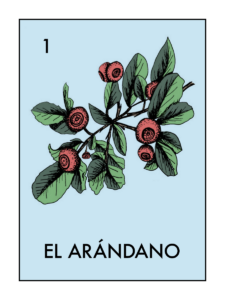
Los arándanos viven en suelos húmedos que tienen buen drenaje. Se pueden encontrar en los bosques verdes de gran altura en Oregón. Los nativos americanos locales tienen una relación significativa con los arándanos basada en generaciones de quemas agrícolas tradicionales, replantaciones, cosechas y ceremonias agrícolas tradicionales. Aunque la quema ha sido prohibida por ley, los indígenas han preservado cuidadosamente esta relación con los arándanos.
Huckleberries live in moist, well-drained soils. They can be found in high elevation evergreen forests in Oregon. Local Native Americans have a significant relationship with huckleberries built on generations of traditional agricultural burning, replanting, harvesting, and ceremony. Though burning has been outlawed, Indigenous peoples have carefully preserved and continued their relationship with huckleberries.
Las plantas de Camas disfrutan las praderas húmedas con buen drenaje al oeste de las Cascadas. Por mucho tiempo, estas plantas han sido una de las principales fuentes de alimentos de las personas indígenas locales. Los bulbos de Camas se comerciaban mucho entre tribus y se usaban en celebraciones. Después que los métodos de quema agrícolas nativos se declararon ilegales, el número de Camas disminuyó bastante. En los últimos años, los proyectos de soberanía alimentaria han hecho un esfuerzo para ayudar a restaurar un hábitat de Camas más natural. Algunas variedades son venenosas, ¡así que ten cuidado y consulta a un profesional antes de comer!
Camas plants enjoy wet, well-drained meadows west of the Cascades. Camas has long been one of the primary food sources of local Indigenous peoples. Camas bulbs were traded extensively between tribes and used in celebrations. Since native agricultural burning methods were made illegal, their numbers have dwindled. In recent years, food sovereignty projects have made efforts to restore camas to more of its natural habitat. Some varieties are poisonous, so use caution and consult a professional before eating!


Los helechos espada necesitan sombra y tierra fértil que esté húmeda. Crecen abundantemente bajo árboles altos en bosques lluviosos. Los helechos espada han existido desde al menos 400 millones de años. Muchas personas indígenas tienen una larga historia con el helecho espada. Han usado helechos espada como medicina, alimento, en juegos tradicionales y en su mitología.
Sword ferns need moist, rich soil and shade. They grow abundantly under tall trees in rainy forests. Sword ferns have been around for at least 400 million years. Many indigenous peoples have long histories with the sword fern. They have used sword ferns as medicine, food, in traditional games, and in their mythology.
La planta de Wapato crece debajo del agua en humedales, en suelo lodoso. Esta planta se puede utilizar en biorremediación eficaz, eliminando metales pesados de los humedales y mejorando la calidad del agua. En los humedales y a lo largo de las costas de los cuerpos de agua, proporciona un hábitat de sombra para peces juveniles y aves acuáticas. Los pueblos indígenas que están cerca del río Columbia conservan los métodos tradicionales de cosecha y formas de cocinar.
Wapato grows underwater in wetlands, in muddy soil. Wapato can be used as an effective bioremediation plant, removing heavy metals from wetlands and improving water quality. In wetlands and along shores of water bodies, Wapato provides habitat and shade for juvenile fish and waterfowl. Indigenous peoples along the lower Columbia River retain traditional harvesting and cooking methods.
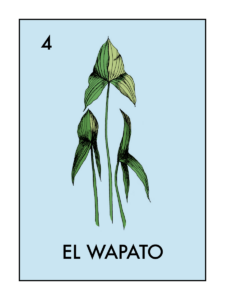
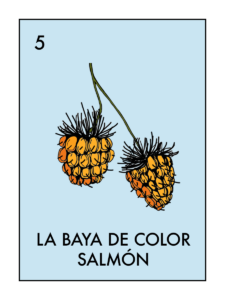
La Baya color Salmón se encuentra en los bosques húmedos, especialmente cerca de los arroyos y ríos. Pueden germinar en áreas alteradas, como en bosques previamente talados. La Baya color Salmón florece de color rosa oscuro en primavera, y maduran más temprano que otras bayas en el noroeste. Los pueblos indígenas las comen comúnmente junto con el salmón.
Salmonberry is found in moist forests, especially along streams and rivers. They can thrive in disturbed areas, such as previously logged forests. Salmonberry vines bloom with dark pink flowers in spring, and their berries are one of the earliest berries to ripen in the Northwest. They are commonly eaten alongside salmon by Indigenous peoples.
El Aliso Rojo crece en pantanos, bosques húmedos y áreas despejadas con mucho sol. Los alisos rojos alimentan al suelo con nitrógeno, lo cual proporciona nutrientes a las plantas vecinas. Los pueblos indígenas también usan el aliso rojo como tinte tradicional, lo que le da al árbol su nombre colorido.
Red Alder grows in swamps, wet woods, and cleared areas with plenty of sun. Red Alders fix nitrogen into the soil, providing nutrition for neighboring plants. Indigenous peoples also use Red Alder as a traditional dye, giving the tree its colorful name.
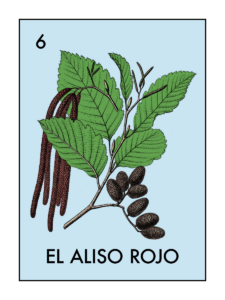
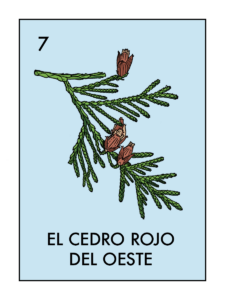
El Cedro Rojo del Oeste crece en suelos húmedos, pantanos y sitios inundados. Puede vivir más de 1000 años. También recibe el nombre de “Dador de vida” y cada parte del árbol tiene un significado para los pueblos indígenas locales. Su madera es increíblemente resistente a la putrefacción, por lo que se presta a muchos usos diferentes una vez cosechada. La madera de cedro se utiliza tradicionalmente para construir canoas y refugios duraderos que resisten el clima húmedo del noroeste.
Western Redcedar grows in wet soils, bogs, and flooded sites, and can live over 1,000 years. Western Redcedar is called the “Giver of Life”, and every part of the tree holds significance for local Indigenous peoples. Its wood is incredibly resistant to rot, lending itself to many different uses once harvested. Cedar wood is traditionally used to build durable shelters and canoes that stand up to the wet Northwest climate.
La Madia se encuentra en sitios abiertos perturbados con elevaciones bajas, a menudo cerca de los bordes de las carreteras o en los claros. Las semillas son aceitosas y comestibles, generalmente utilizadas como alimento básico por los pueblos indígenas y molidas en harina, tostadas o hechas en pan. El aceite también se puede utilizar para cocinar.
Tarweed is found in open, disturbed sites at low elevations, often near roadsides or in clearings. The seeds are oily and edible, often used as a staple food by Indigenous peoples and pounded into flour, roasted, or made into breads. The oil can also be used for cooking.

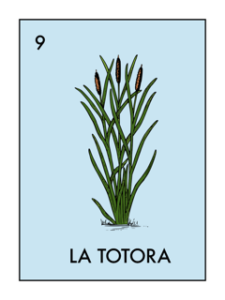
Las Totoras se encuentran en pantanos, aguas de movimiento lento o zanjas. Las hojas de totora han sido utilizadas comúnmente por los pueblos indígenas para tejer esteras, ropa de cama, mantas, bolsos, sombreros y capas. La pelusa de totora se puede utilizar para rellenar almohadas y colchones, vendar heridas y para forrar pañales.
Cattails are found in marshes, slow moving water, or ditches. Cattail leaves have been commonly used by Indigenous peoples to weave mats, bedding, blankets, bags, hats, and capes. Cattail fluff can be used for stuffing pillows and mattresses, to dress wounds, and line diapers.
Los robles crecen en prados soleados, áreas rocosas secas o suelos bien drenados. Se encuentran predominantemente al oeste de la cordillera de las Cascadas y en elevaciones bajas, como el valle de Willamette. Los robles blancos de Oregón crecen lentamente, pero pueden vivir hasta 500 años en las condiciones adecuadas. La planta de Camas prospera en los bosques abiertos que crean los robles. Las bellotas de los robles blancos de Oregón son un alimento tradicional e importante para las gentes indígenas del valle de Willamette. Ellos usan un proceso de varios pasos para preparar las bellotas para comer.
Oaks grow in sunny meadows, dry rocky areas, or well-drained soils. They are predominantly found west of the Cascade range and at low elevations, such as the Willamette Valley. Oregon White Oaks grow slowly, but can live to 500 years in the right conditions. Camas thrives in the open woodlands that oaks create. Acorns from Oregon White Oaks are an important traditional food for Willamette Valley tribes, and they use a multi-step process to prepare the acorns for eating.

This project was funded by USACE-PSU cooperative agreement W9127N2120010.
Cards 1-4 by Melody Midkiff and Drew Haven. Cards 5 and 9 by Daniela Ortiz Mendez with illustrations used with permission from SeekPNG and Mystoks. Cards 6, 7, 8, and 10 by Drew Haven with illustrations used with permission from Useful Temperate Plants, ClipArt Etc, and Wikimedia Commons.